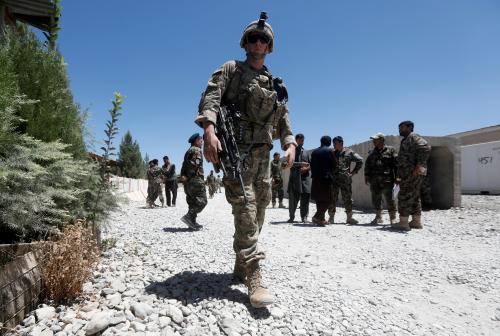In a Washington Post op-ed, Madiha Afzal and Michael O’Hanlon write, “We believe that the correct answer is to stay. As difficult as it is to remain in this longest war, the most likely outcome of pulling out of Afghanistan would be very ugly, including ethnic cleansing, mass slaughter and the ultimate dismemberment of the country.”
Can the United States, under the Biden administration, responsibly end its forever war in Afghanistan?
The White House reportedly has a new idea on how to try, after watching peace talks in Qatar between the Afghan government and the Taliban flounder over the past year. It is proposing an international summit including Afghan leaders and the Taliban. The initial goal would be to create an interim power-sharing government, which would buy time for more comprehensive peace talks thereafter. This would also allow the United States and NATO to keep their small military footprint in place for a while longer, beyond the May cutoff that some believe the February 2020 deal between Washington and the Taliban requires.
Unfortunately, this diplomatic Hail Mary is very unlikely to produce a quick accord. Whatever leverage President Biden can generate over Afghan President Ashraf Ghani, including the implied threat of a quick U.S. and NATO troop departure, the Taliban is unlikely to accept the demand for a 90-day reduction in violence. Its leaders are also unlikely to agree to meaningful power-sharing — especially if they sense we are already halfway out the door.
Thus, Biden will still likely have to decide: Do we stay or do we go? We believe that the correct answer is to stay. As difficult as it is to remain in this longest war, the most likely outcome of pulling out of Afghanistan would be very ugly, including ethnic cleansing, mass slaughter and the ultimate dismemberment of the country.
In weighing the United States’ options, the president certainly needs to bear in mind the costs of the current U.S. deployment — 2,500 U.S. troops out of a NATO-mission total of 9,000, perhaps $10 billion per year in expense to the U.S. taxpayers, and the prospect of perhaps 10 to 20 American casualties a year if the Taliban resumes its previous use of force against U.S. forces. But Biden also needs to form an expectation of what would likely happen after any NATO departure.
First, if we pull out the remaining U.S. troops, those of other foreign nations will leave, too. NATO depends on the United States for key combat and intelligence capabilities and leadership.
Second, despite the departure of troops, U.S. and NATO military assistance in the form of money and equipment will likely continue to flow to Afghan government forces. After all, why would we abandon them after fighting alongside them for 20 years? Thus, both the Taliban and Kabul will have the wherewithal to maintain the fight. The war will continue, and it will move into Afghanistan’s cities, which have generally remained under government control throughout the past two decades.
Third, no rapid progress towards a peace accord will occur. Taliban leaders will be more certain than ever that time is on their side. The Ghani government will still believe it has leverage and legitimacy by virtue of its constitution, as well as international diplomatic recognition and financial support. Their fundamental ideological differences remain: The Taliban wants an Islamist emirate, Kabul wants a democratic government.
Fourth, while existing battlefield dynamics already favor the Taliban, those dynamics could be exacerbated after a U.S. and NATO departure — with terrible humanitarian consequences. As some cities fall to partial or complete Taliban control, and the Taliban exacts leverage on those it considered collaborators with the regime, there would be powerful incentives for opponents to prevent its infiltration into other cities. Most Pashtun (Afghanistan’s largest ethnic group) are not Taliban and do not support the Taliban. However, virtually all Taliban are Pashtun. Thus, if you are from a Tajik, Hazara or Uzbek ethnic group, the simplest way to protect yourself is to hunker down above the Hindu Kush mountains in the nation’s north and push out all Pashtun. That is a recipe for ethnic cleansing, and massive human suffering throughout the country.
Fifth, the result of all this would be an enormous refugee strain on neighboring Pakistan, risking instability in that important country of more than 220 million. Some might believe Pakistan could prop up a Taliban regime in Afghanistan, much as in the 1990s, but that assumption ignores the Taliban’s evolution away from Pakistani control, and Pakistan’s own difficult experience with militancy over the past 20 years. Today’s Pakistan probably does not want an exclusively Taliban-run Islamist emirate on its Western flank.
Sixth and finally — a small silver lining — the new rump Afghanistan in the nation’s northeast would likely become a friend of the West, much like Kurdistan in Iraq. It would likely welcome not only financial aid but also Western military and intelligence capabilities. Alas, the scale of the terrorism problem would likely have grown a great deal in the meantime, as the Taliban would be even less likely to break with al-Qaeda than it is today, and most or all of the nation’s southeast would be under its control. Along the way, the Afghanistan war’s current tragic death tolls, measured in the tens of thousands a year, would surely have multiplied.
The Brookings Institution is committed to quality, independence, and impact.
We are supported by a diverse array of funders. In line with our values and policies, each Brookings publication represents the sole views of its author(s).











Commentary
Why staying in Afghanistan is the least bad choice for Biden
March 12, 2021